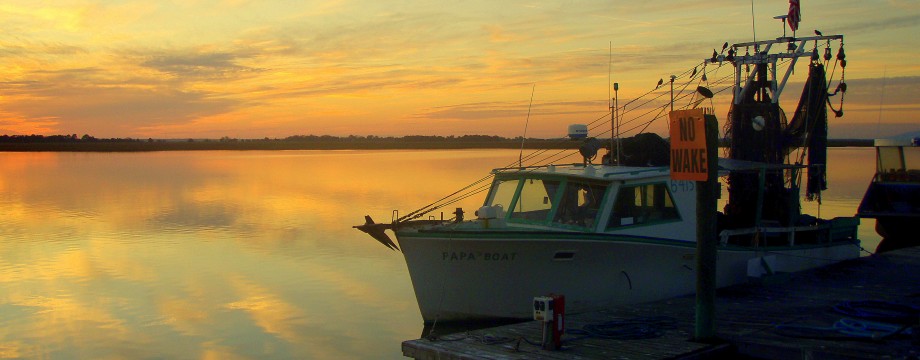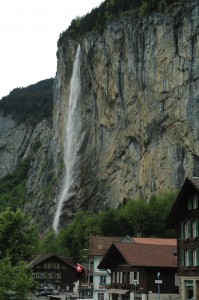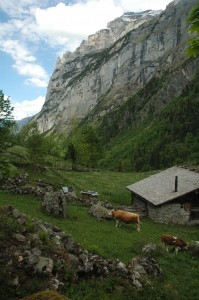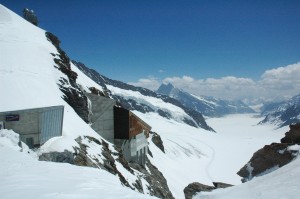In Switzerland’s Jungfrau , snow-capped peaks caress the sky as clouds hide their lofty summits. Valleys separated by a single ridge of mountains seem worlds apart offering distinctly different views and experiences within a few minutes travel.
The well-known, tourist laden Interlaken, complete with the American bred Hooters franchise, acts as a gateway to this area known for breathtaking sights, adventure sports and unending beauty. Hiking, skiing, paragliding and base jumping are all common practice within the Jungfrau , named for one of the Alps’ highest points.
Jungfrau stands at 13,642 foot, high above the valley floors below. To one side is the more popular ski resort town of Grindelwald, on the other is the lesser known Lauterbrunnen Valley.
Often seen as only a day trip from the commercialized areas of Interlaken and Grindelwald, the Lauterbrunnen valley leaves visitors slack jawed in amazement and rushing to catch their breath for the next glorious sight.
Carved long ago by glaciers, the Lauterbrunnen Valley is a lush, green agriculture land, half a mile wide at its largest point. Dominating the landscape and distracting from the carpet of spring wildflowers are the valley walls rising nearly 1,000 feet on both sides as dozens of waterfalls rage down the sheer face along the three mile deep valley. From glacial and snow melt, waterfalls are fed at varying degrees of volume, some roaring down the cliff face while others pour off the lip turning to mist before reaching the valley floor in a cascading rainbow.
The town of Lauterbrunnen lies at the only entrance to this canyon valley with small hamlets of a dozen buildings each resting on the floor strictly tending their livestock of cattle, sheep, goats and horses as haste is made in collecting hay before spring rains roll through the valley.
Other villages along the Lauterbrunnen Valley are only accessible by cable cars ascending at an alarmingly steep angle of attack reaching the top in three to five minutes. For children, these gondolas act as school buses and grocery laden locals regularly accompany tourists and base jumpers to the top.
The largest of these villages along the Lauterbrunnen’s sharp lip is the town of Mürren, a small collection of homes, shops and restaurants overlooking the long narrow valley below glowing green with life while the intimidating peaks of the Eiger, Mönch and Jungfrau soar above adorned in gleaming white.
Further into the valley, just before a descent into a pristine and wild nature preserve crisscrossed with hiking trails, lies Gimmelwald, home to only a couple dozen residents and even fewer tourists. Here, livestock outnumber people and eateries are few.
Although views and memories from this valley are priceless, take into account a steep price for public transportation. Discounts can be garnered on most lines for Eurail pass holders but the cost for busses, trains and cable cars can still amount to a princely figure for a multi-day trip. If lingering in the Jungfrau , be sure to ask about the regional transportation pass priced at CHF 200. (Swiss Francs)
Cable cars such as those reaching Gimmerwald and Mürren, are available across the region for access to ski lifts in the winter and stunning hiking trails in the spring and summer. Taking a five-minute gondola can often save hikers between two and three hours of uphill struggle leaving only the most scenic and enjoyable sections of trail to be traversed.
From the other side of the valley, Grindelwald and its surrounding villages offer a separate experience. Large supermarkets replace closet size markets and outfitters line the streets hawking brand name apparel. Feeling immensely similar to a ski town anywhere else in the world, Grindelwald may not possess the same alpine charm as villages in the Lauterbrunnen Valley, but a new network of trails and slopes await the outdoor enthusiast. Outside of city limits, the countryside is undoubtedly Swiss and the views are wholly irreplaceable.
In the spring, hiking options may be slightly repressed as some cable cars remain shuttered for the winter, but from late May and early June, all trails are open and regularly utilized. Take a gondola to Pfinstegg for a hike to the Obrer glacier at which point you’re asked to pay CHF 5 for the agony of climbing 900 crude wooden stairs. At the end of the grueling trek, make your way across the swinging bridge to see the top of the glacier in the distance. A decade ago, no bridge was needed and the glacier loomed some 30 feet away, but today, after crossing the concessionary bridge, the glacier remains nearly a quarter-mile out.
Years could be spent scouring the spring and summer trails of this region, but no trip would be complete without a ride to Jungfraujoc, the highest train station in Europe. Located on a ridge just below the Jungfrau summit, the station is reached by a slow moving train at a steep grade ascending from either Grindelwald or Lauterbrunnen and all points in between. Be sure to budget for this ticket, though, as normal fare is CHF 180. A Eurail pass brings the total to CHF 125 or the regional pass will cut the normal ticket price in half.
The ascent alone is remarkable in itself as an engineering feat, completed in 1912, boring straight through the mountain. An elevator brings guests to the highest viewing point at 11,760 feet. The observatory is shared by scientists at an important and world renowned monitoring station for astrology and environmental research. Elsewhere amid the train station is a ski and snow tubing slope open year round. Beneath the station lies an ice cavern made accessible to visitors complete with ornate carvings. On the way down from the top, make sure to grab a seat facing the summit in order to more easily keep your seat on the steep journey down.
Time spent in the Jungfrau region seems to pass all too quickly as days are filled with sensory overload from the sights and sounds of a magical alpine landscape. For the first time on this grand adventure, in leaving I felt a genuine sense of regret, contemplating a lengthened stay and reminded of the classic western song – Red River Valley. “From this valley, they say you are leaving. … Do not hasten to bid me adieu.”








2 Responses to Adventures in Switzerland